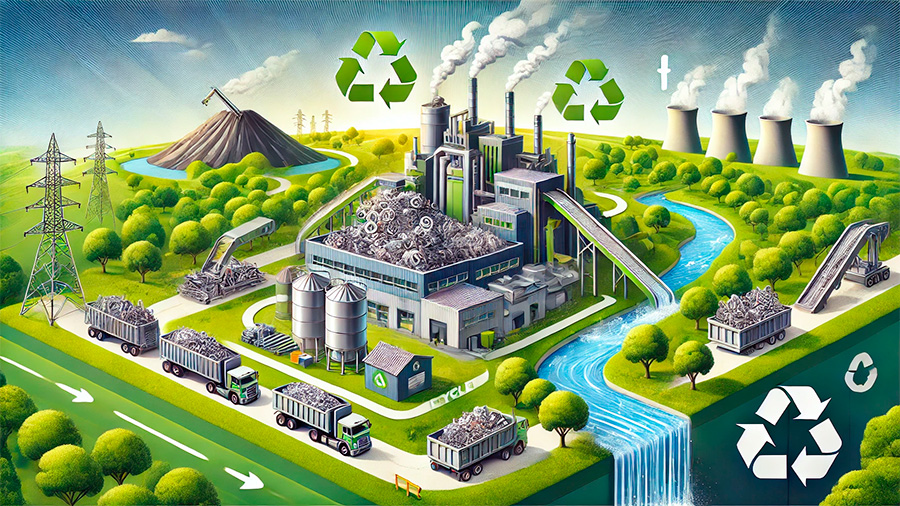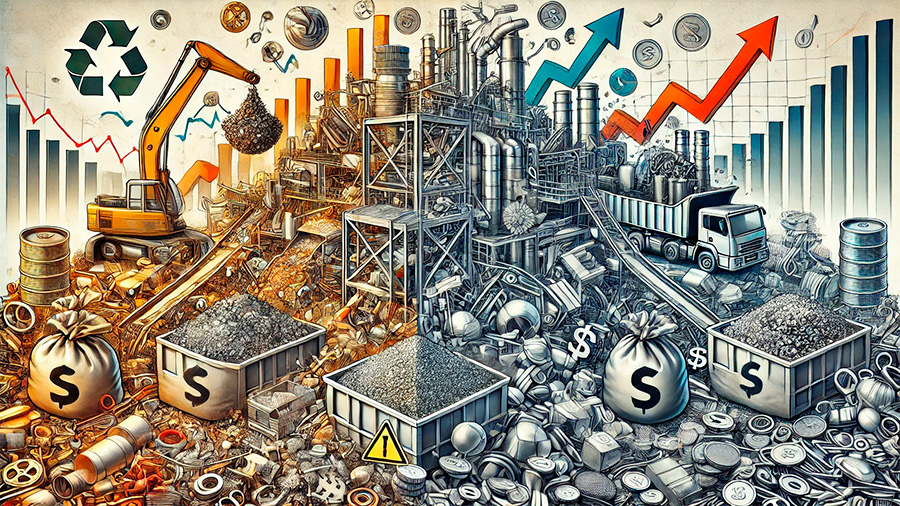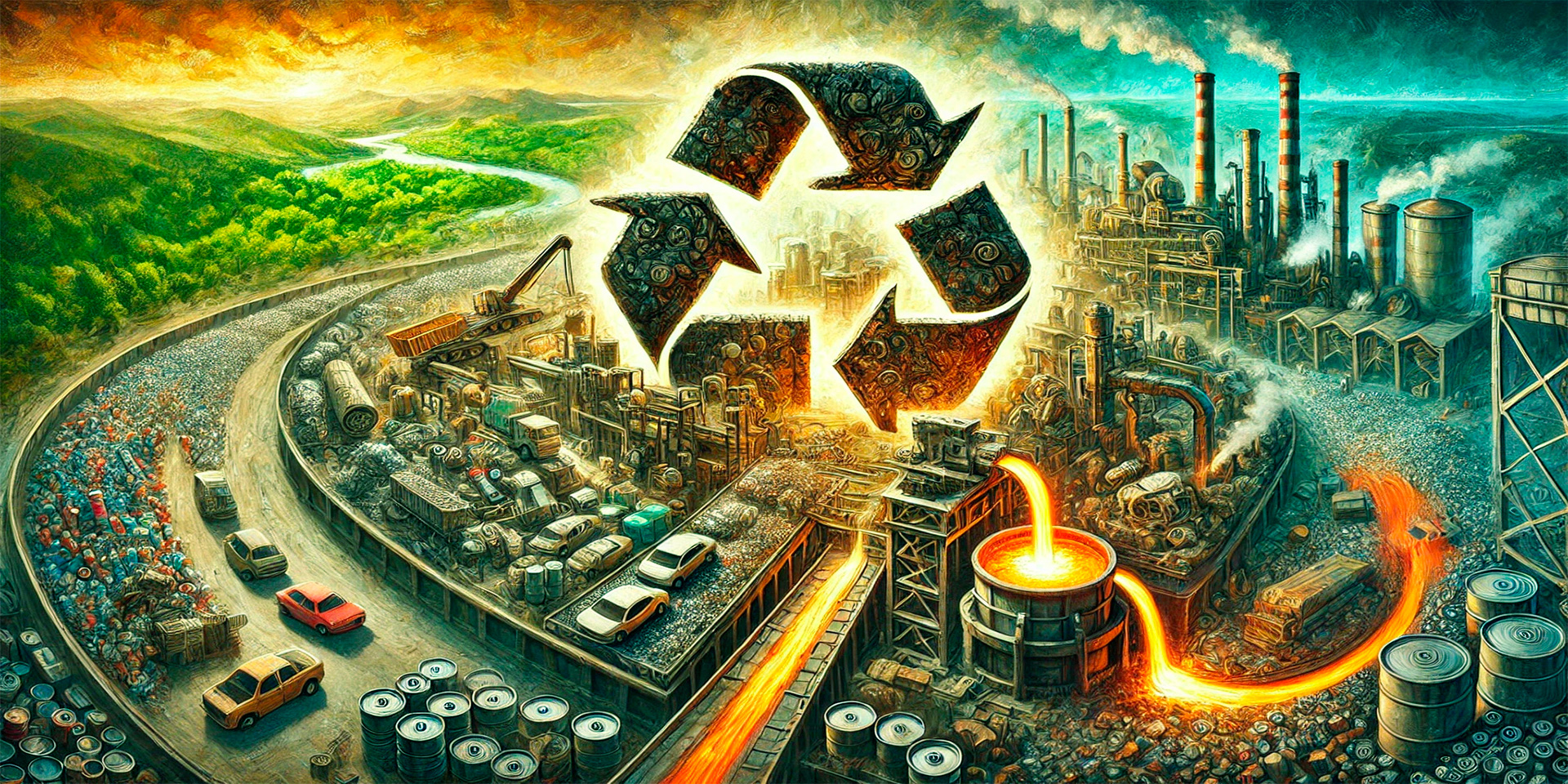As the global demand for raw materials continues to grow, the issue of resource scarcity has become more pressing. The extraction of finite natural resources, such as metals, often leads to environmental degradation and long-term economic challenges. Metal recycling has emerged as a crucial solution to mitigate these problems by reducing the need for mining, conserving natural resources, and minimizing waste. By reprocessing metals from end-of-life products, we can extend the lifecycle of these resources, reduce environmental harm, and contribute to a more sustainable, circular economy. This article explores the importance of metal recycling in the fight against resource scarcity and its broader environmental and economic implications.
The Importance of Metal Recycling in Resource Management
Metals like aluminum, copper, gold, and steel are essential components in a wide range of industries, from construction and transportation to electronics and manufacturing. However, these metals are finite, and mining them can be both costly and environmentally damaging. Recycling metals allows us to meet industrial demand without depleting natural resources and to minimize the adverse effects of mining on the planet.
1. Reducing the Need for Mining
Mining for raw metals requires substantial energy and labor, not to mention significant environmental impact, including habitat destruction, water pollution, and carbon emissions. By recycling metals, we reduce the demand for new mining projects, which helps preserve ecosystems and conserve natural resources. The recycling process uses less energy and fewer raw materials than mining, making it a more sustainable option.
How recycling reduces reliance on mining:
- Lower energy consumption: Recycling metals requires up to 95% less energy than extracting and refining virgin metals, which reduces the carbon footprint of metal production.
- Preserving ecosystems: By recycling metals instead of mining new ones, we avoid the deforestation, pollution, and ecosystem disruption caused by large-scale mining operations.
- Conserving resources: Recycling helps extend the lifespan of finite metal resources, reducing the need for continued extraction and ensuring that these resources are available for future generations.
2. Recycling as a Sustainable Economic Solution
The economic benefits of metal recycling extend beyond environmental considerations. Recycling can lower the cost of raw materials, create jobs, and support the transition to a more circular economy, where the waste from one product becomes the resource for another. This model promotes efficiency and sustainability while reducing reliance on newly mined resources.
The economic advantages of metal recycling:
- Lower production costs: Using recycled metals in manufacturing can be cheaper than sourcing virgin materials, particularly in sectors like aluminum production, where recycling costs are significantly lower than mining and refining.
- Job creation: Recycling industries provide jobs in collection, processing, and sorting, contributing to local economies and providing stable employment opportunities.
- Circular economy growth: Recycling is central to the circular economy model, where products and materials are reused, refurbished, and remanufactured to minimize waste and maximize resource efficiency.

The Role of Metal Recycling in Reducing Waste and Pollution
Recycling metals not only conserves resources but also reduces the volume of waste sent to landfills, helping to mitigate pollution and environmental degradation. The process of extracting raw metals from ores generates significant waste, including tailings and hazardous byproducts. By recycling metals, we reduce this waste and its impact on the environment.
1. Decreasing Landfill Waste
A significant portion of metal products ends up in landfills at the end of their life cycle, contributing to environmental pollution and waste accumulation. Metal recycling helps divert these materials from landfills, reducing the overall waste burden. By recycling metals, we can reduce landfill usage and ensure that valuable resources are reused instead of discarded.
The role of recycling in waste reduction:
- Reducing landfill burden: By recycling metals, we keep millions of tons of waste out of landfills, which helps reduce the environmental impact of waste disposal.
- Reducing landfill methane emissions: Organic waste in landfills can produce methane, a potent greenhouse gas. Reducing landfill waste through recycling helps mitigate these emissions.
- Maximizing resource recovery: Metal recycling recovers valuable materials from end-of-life products, turning waste into usable resources and reducing the need to mine new raw materials.
2. Lowering Environmental Pollution
The environmental consequences of mining include air and water pollution, habitat destruction, and the release of toxic chemicals into ecosystems. Recycling metals, on the other hand, helps eliminate many of these environmental threats. Since recycling uses less energy and produces fewer emissions, it reduces the carbon footprint of metal production and helps protect the environment.
How recycling reduces pollution:
- Fewer emissions: Recycling metals, especially aluminum and steel, produces significantly fewer carbon emissions compared to mining and processing virgin metals.
- Water conservation: Metal recycling uses less water than mining, which helps conserve this precious resource and reduces the risk of water contamination from mining operations.
- Reduced toxic waste: Mining operations often produce toxic byproducts that can contaminate soil and water. Recycling metals reduces the need for new mining and, consequently, the creation of toxic waste.

Challenges in Metal Recycling
While metal recycling offers numerous benefits, it is not without its challenges. For example, the recycling process is not always as efficient as it could be, and certain types of metals can be difficult to recycle. Moreover, the economic feasibility of recycling is influenced by factors such as market demand and the cost of recycling technologies.
1. Contamination of Recyclable Metals
One of the challenges in metal recycling is contamination, which occurs when different types of metals or non-metal materials are mixed together. Contaminated materials are harder to process and may result in lower-quality recycled metals. Ensuring that recyclable metals are properly sorted and cleaned is essential to maximizing recycling efficiency.
Challenges with metal contamination:
- Mixed metals: When different metals are mixed, such as aluminum with steel, the recycling process becomes more complex and may result in a lower-quality end product.
- Non-metal contamination: Non-metal materials, such as plastics or ceramics, can contaminate metal recyclables, making it difficult to extract pure metals for reuse.
- Lower yield rates: Contaminated metals may yield fewer valuable materials or lower-quality products, affecting the economic viability of recycling programs.
2. The Cost of Recycling Technologies
The cost of recycling technologies can be a barrier for some businesses, particularly those in developing countries or small-scale operations. Advanced technologies, such as automated sorting systems and smelting furnaces, are necessary to improve recycling efficiency, but these technologies require significant capital investment.
Economic challenges in recycling:
- High upfront costs: The initial investment in recycling infrastructure and technology can be substantial, making it challenging for some companies to adopt these systems.
- Operational costs: While recycling reduces raw material costs in the long run, the ongoing costs of collection, sorting, and processing can still be significant.
- Market fluctuations: The price of recycled metals can fluctuate with market demand, making it difficult for recycling operations to maintain consistent profits.
The Future of Metal Recycling
As global resource scarcity becomes an increasingly pressing issue, metal recycling will play an even more significant role in the economy. Advances in recycling technology, increased awareness of environmental issues, and more stringent regulations will drive the growth of metal recycling industries. Additionally, expanding public-private partnerships and government incentives for recycling initiatives will help address current challenges and further integrate recycling into the global economy.
1. Innovations in Recycling Technology
New technologies in sorting, processing, and smelting are making metal recycling more efficient and cost-effective. Advances in automation, artificial intelligence, and robotics are enabling more precise sorting of metals, improving recycling yields and quality. Innovations in hydrometallurgy and biotechnological processes are also enhancing the extraction of metals from complex waste streams.
Technological advancements in metal recycling:
- Automation and AI: Automated sorting systems powered by AI can identify and separate different metals, improving recycling efficiency and reducing contamination.
- Hydrometallurgy: Innovative chemical processes are being developed to extract metals from low-grade ores and recycling waste, making it possible to recover more metals from complex waste streams.
- Biotechnology: Researchers are exploring the use of microbes to extract metals from waste, offering an environmentally friendly alternative to traditional mining methods.
2. The Role of Policy and Regulation
Governments and international organizations are implementing policies to promote metal recycling and reduce waste. These regulations can include mandates for recycling rates, incentives for recycling businesses, and penalties for excessive waste production. Policy-driven demand for recycled metals will continue to grow, incentivizing more industries to invest in recycling technologies and infrastructure.
The role of policy in promoting recycling:
- Extended Producer Responsibility (EPR): Many governments are implementing EPR programs, which require manufacturers to take responsibility for the disposal and recycling of their products at the end of their life cycle.
- Recycling mandates: Regulations that require industries to meet specific recycling targets are encouraging businesses to develop more efficient recycling processes and reduce their reliance on virgin materials.
- Financial incentives: Governments may provide financial incentives such as tax breaks or subsidies to businesses that invest in recycling technologies and infrastructure.
Conclusion
Metal recycling plays a vital role in reducing resource scarcity, minimizing environmental impact, and supporting the transition to a circular economy. While challenges remain, such as contamination, high operational costs, and fluctuating market prices, the economic and environmental benefits of metal recycling far outweigh these obstacles. As recycling technologies improve and governments continue to implement supportive policies, metal recycling will continue to be a cornerstone of sustainable resource management, helping to reduce reliance on finite natural resources while promoting economic growth and environmental stewardship.

